MENU
Close
Best Adhesive for Plastic to Rubber
The best adhesive for bonding plastic to rubber depends on various factors such as the specific types of plastic and rubber involved, the intended application, and environmental conditions. However, here are some commonly used adhesives that are effective for bonding plastic to rubber:
- Cyanoacrylate Adhesives (Super Glue): Cyanoacrylate adhesives are known for their fast curing time and strong bonding properties. They can create a strong bond between many types of plastic and rubber surfaces. Super glue is suitable for small-scale bonding applications and offers good initial strength.
- Two-Part Epoxy Adhesives: Two-part epoxy adhesives provide excellent bonding strength and durability. They consist of a resin and a hardener that need to be mixed before application. Once cured, epoxy forms a strong and lasting bond between plastic and rubber surfaces.
- Polyurethane Adhesives: Polyurethane adhesives offer flexibility and resilience, making them suitable for bonding plastic to rubber. They provide a strong bond that can withstand impact and environmental factors. Polyurethane adhesives are often used in automotive, construction, and industrial applications.
- Rubber-Based Adhesives: Rubber-based adhesives are specifically formulated for bonding rubber to various substrates, including plastic. They offer good adhesion and flexibility, accommodating the different expansion rates of plastic and rubber. Rubber-based adhesives are suitable for applications where a flexible bond is required.
- Silicone Adhesives: Silicone adhesives are known for their flexibility and resistance to temperature extremes and moisture. They can effectively bond plastic to rubber surfaces and provide good adhesion over a wide range of temperatures. Silicone adhesives are often used in sealing and bonding applications.
When selecting an best adhesive for bonding plastic to rubber, consider factors such as the specific requirements of your application, the compatibility of the adhesive with the materials involved, and the environmental conditions. Always follow the manufacturer’s instructions for surface preparation and application to achieve optimal bonding results.
